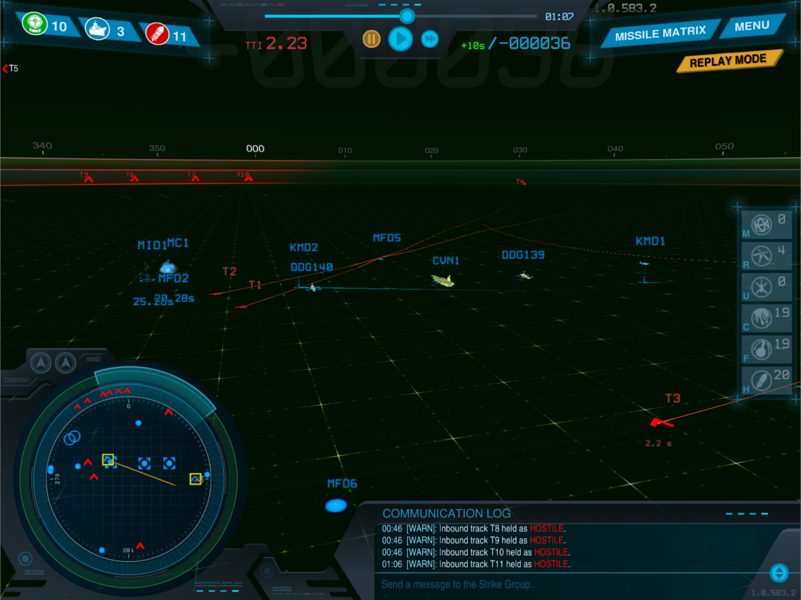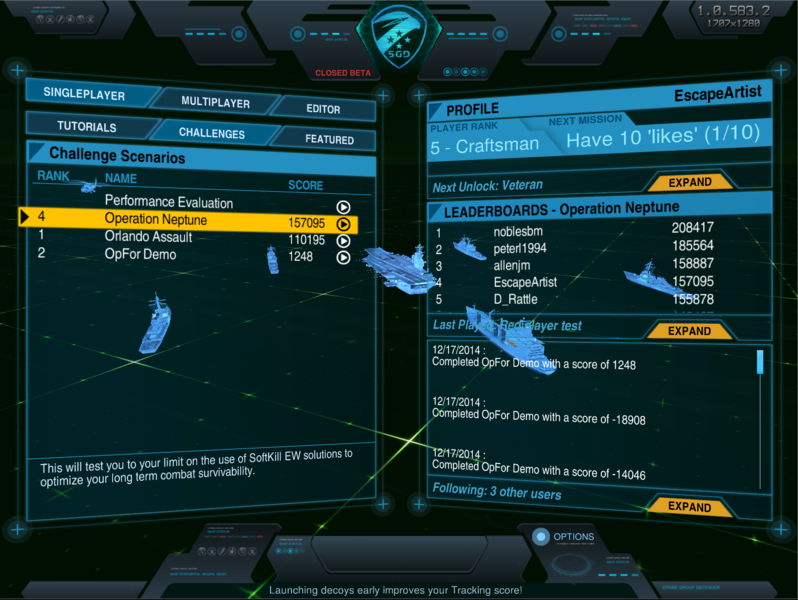A panel of international judges at the 2014 Interservice/Industry Training, Simulation, and Education Conference (I/ITSEC) selected "Strike Group Defender: The Missile Matrix" as the best serious game entered by a government organization into the Serious Games Showcase and Challenge (SGS&C). The interactive video game was developed by researchers from MIT Lincoln Laboratory's Advanced Concepts and Technologies Group and the Office of Naval Research (ONR) to improve the training available to U.S. Navy personnel for learning optimal planning considerations and tactical responses to threats from modern antiship cruise missiles.
"The game provides an ecosystem for learning," says Reed Jensen, one of the prime developers from Lincoln Laboratory. "The goal is to make the concepts of defense against cruise missiles accessible by immersing trainees in a simulated environment." Additional research-and-development and science-and-technology objectives were to create a high-impact, low-cost product that could be fielded quickly, sustained economically, and modified in near real-time, as well as operated at the quality of today's commercial game-based products, yet in a much-reduced-bandwidth environment.
In the game, players are challenged to react to cruise missiles heading toward their ships. Although players can choose to intercept the missiles or to deploy decoys to divert the missiles from their targets, the game is designed to promote the effective use of decoys. Players earn rewards when their decoys draw adversary missiles away from their ships.
A game environment offers a number of advantages for instructional programs. The compelling nature of a competitive game keeps players interested and focused during training sessions and often motivates trainees to experiment with the game on their own time. Game logs that provide feedback on the actions operators make during the simulations can fuel improvements to the training scenario by providing insights into the operators' decision-making processes. In addition, when games are played in teams, players hone their collaboration skills.
"Using decoys effectively can be a complex process, especially when facing advanced cruise missile threats," says Jensen. "In our trials so far, we have observed that a game-based environment has helped novice users grasp basic decoy deployment concepts after only a few minutes of play. Our hope is that our game-based instruction and analytics infrastructure will become a useful tool for disseminating future Navy weapons concepts, tactics, and training."
"Strike Group Defender" was one of dozens of educational or instructional video games showcased at the SGS&C. Assigned to one of three primary categories — business, government, or student — these interactive games are judged on their originality and effectiveness in meeting clearly defined learning objectives. Through a partnership with I/ITSEC and the National Training and Simulation Association, the SGS&C was established in 2005 to generate interest in the use of digital game technology for training and education. The SGS&C has grown to be a key segment of I/ITSEC, which in recent years has been attracting approximately 10,000 visitors from the military, industry, and academia to its week of presentations and exhibits. The 2014 I/ITSEC, which was held Dec. 1-5, 2014, in Orlando, Florida, and drew attendees from 70 countries, was again the world's largest forum for sharing innovative applications of modeling and simulation techniques to training programs.
"Strike Group Defender" was originally conceived as a virtual "demo space" for the capabilities being developed in two ONR Science and Technology Integrated Air and Missile Defense Future Naval Capability (FNC) initiatives, focusing on optimal hard kill/soft kill (HK/SK) coordination. These projects were managed by PMR 51, with Lincoln Laboratory serving as the technical lead.
The initial iteration of the demo space was the Red Team/Blue Team simulation shown at the 2013 Air and Missile Defense Technology Workshop held at Lincoln Laboratory. In the Red/Blue exercises, participants playing as the Red Team took the role of an adversary and formulated missile configurations that would negate or eliminate Blue Team ships. The Blue Team tried to anticipate Red Team actions and devised decoy deployment strategies to counter them in real time. Scott Orosz, the PMR 51 FNC project manager, saw the potential of using elements of the Red/Blue simulation not only as an FNC demo space but also as a basis for a planning tool and training simulation to markedly improve Navy electronic warfare operators', strike group planners', and tactical action officers' understanding of HK/SK trade-offs and to directly facilitate development of improved tactics for countering cruise missile attacks.
Lincoln Laboratory supplied technical direction for the game and developed the basic concepts Strike Group Defender would teach. This project was directed by the Advanced Concepts and Technologies Group, with Jensen and Mark Jones leading the effort, and included key support from Steven Nelson of the Ballistic Missile Defense System Integration Group. Vendors and serious games experts, Metateq and PipeWorks, advised the laboratory on transitioning the Red/Blue simulation into a commercial-quality video game with engaging visuals and gameplay. These vendors also incorporated into the simulation a robust analytics infrastructure that utilizes crowdsourcing, big data, cloud computing, and behavior analysis to support comprehensive human-performance requirements and real-time tactical assessments.
Currently, about 115 shipboard naval personnel are testing "Strike Group Defender." Their success with and critiques of the game will help determine modifications to the program. Future versions of the game may add more analytical tools that will help commanders evaluate users' understanding of defense strategies. In addition, game weapons and scenarios will be adapted to respond to emerging situations in ship defense.







